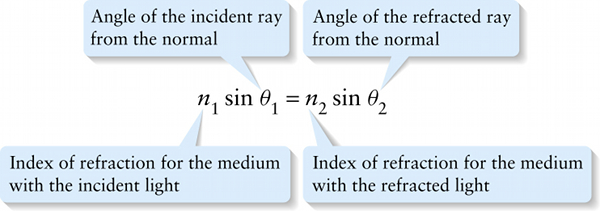Snell’s law of refraction (23-6)
Question
Angle of the refracted ray from the normal
{"title":"Angle of the incident ray from the normal","description":"Wrong","type":"incorrect","color":"#99CCFF","code":"[{\"shape\":\"poly\",\"coords\":\"82,133\"},{\"shape\":\"rect\",\"coords\":\"10,16,12,16\"},{\"shape\":\"poly\",\"coords\":\"144,22\"},{\"shape\":\"rect\",\"coords\":\"97,5,122,34\"}]"} {"title":"Angle of the refracted ray from the normal","description":"Correct!","type":"correct","color":"#008000","code":"[{\"shape\":\"rect\",\"coords\":\"267,3,291,36\"}]"} {"title":"Index of refraction for the medium with the refracted light","description":"Incorrect","type":"incorrect","color":"#ffcc00","code":"[{\"shape\":\"rect\",\"coords\":\"168,11,191,37\"}]"} {"title":"Index of refraction for the medium with the incident light","description":"Incorrect","type":"incorrect","color":"#000080","code":"[{\"shape\":\"rect\",\"coords\":\"1,11,22,37\"}]"}Review
Equation 23-6 is known as Snell’s law of refraction. (The law is so named because it was deduced by the seventeenth-century Dutch scientist Willebrord Snellius. In fact, Equation 23-6 was first discovered by the Persian scientist Ibn Sahl in 984, more than 600 years before Snellius.)
Snell’s law tells us that when a ray of light crosses from one medium to another, the product of the index of refraction and the sine of the angle the ray makes to the normal remains constant. When light passes into a material of higher index of refraction—for example, from air into glass—so that the speed of light is slower in the second medium and n2>n1, the sine of the refracted angle and the angle itself both decrease. In this case θ2<θ1 and the light bends closer to the normal (Figure 23-6a). When light instead passes into a material of lower index of refraction—for example, from glass into air— so that the speed of light is faster in the second medium and n2<n1, the sine of the refracted angle and the angle itself both increase. In this situation θ2>θ1 and the light bends away from the normal (Figure 23-6b).

